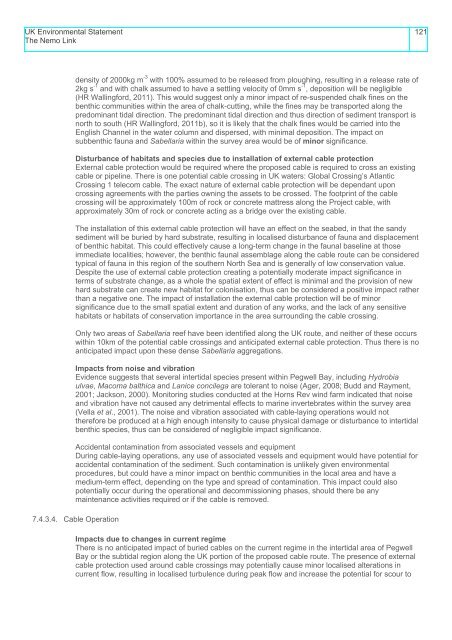Nemo-Link-UK-Marine-Environmental-Statement
Nemo-Link-UK-Marine-Environmental-Statement
Nemo-Link-UK-Marine-Environmental-Statement
You also want an ePaper? Increase the reach of your titles
YUMPU automatically turns print PDFs into web optimized ePapers that Google loves.
<strong>UK</strong> <strong>Environmental</strong> <strong>Statement</strong>The <strong>Nemo</strong> <strong>Link</strong>121density of 2000kg m -3 with 100% assumed to be released from ploughing, resulting in a release rate of2kg s -1 and with chalk assumed to have a settling velocity of 0mm s -1 , deposition will be negligible(HR Wallingford, 2011). This would suggest only a minor impact of re-suspended chalk fines on thebenthic communities within the area of chalk-cutting, while the fines may be transported along thepredominant tidal direction. The predominant tidal direction and thus direction of sediment transport isnorth to south (HR Wallingford, 2011b), so it is likely that the chalk fines would be carried into theEnglish Channel in the water column and dispersed, with minimal deposition. The impact onsubbenthic fauna and Sabellaria within the survey area would be of minor significance.Disturbance of habitats and species due to installation of external cable protectionExternal cable protection would be required where the proposed cable is required to cross an existingcable or pipeline. There is one potential cable crossing in <strong>UK</strong> waters: Global Crossing’s AtlanticCrossing 1 telecom cable. The exact nature of external cable protection will be dependant uponcrossing agreements with the parties owning the assets to be crossed. The footprint of the cablecrossing will be approximately 100m of rock or concrete mattress along the Project cable, withapproximately 30m of rock or concrete acting as a bridge over the existing cable.The installation of this external cable protection will have an effect on the seabed, in that the sandysediment will be buried by hard substrate, resulting in localised disturbance of fauna and displacementof benthic habitat. This could effectively cause a long-term change in the faunal baseline at thoseimmediate localities; however, the benthic faunal assemblage along the cable route can be consideredtypical of fauna in this region of the southern North Sea and is generally of low conservation value.Despite the use of external cable protection creating a potentially moderate impact significance interms of substrate change, as a whole the spatial extent of effect is minimal and the provision of newhard substrate can create new habitat for colonisation, thus can be considered a positive impact ratherthan a negative one. The impact of installation the external cable protection will be of minorsignificance due to the small spatial extent and duration of any works, and the lack of any sensitivehabitats or habitats of conservation importance in the area surrounding the cable crossing.Only two areas of Sabellaria reef have been identified along the <strong>UK</strong> route, and neither of these occurswithin 10km of the potential cable crossings and anticipated external cable protection. Thus there is noanticipated impact upon these dense Sabellaria aggregations.Impacts from noise and vibrationEvidence suggests that several intertidal species present within Pegwell Bay, including Hydrobiaulvae, Macoma balthica and Lanice concilega are tolerant to noise (Ager, 2008; Budd and Rayment,2001; Jackson, 2000). Monitoring studies conducted at the Horns Rev wind farm indicated that noiseand vibration have not caused any detrimental effects to marine invertebrates within the survey area(Vella et al., 2001). The noise and vibration associated with cable-laying operations would nottherefore be produced at a high enough intensity to cause physical damage or disturbance to intertidalbenthic species, thus can be considered of negligible impact significance.Accidental contamination from associated vessels and equipmentDuring cable-laying operations, any use of associated vessels and equipment would have potential foraccidental contamination of the sediment. Such contamination is unlikely given environmentalprocedures, but could have a minor impact on benthic communities in the local area and have amedium-term effect, depending on the type and spread of contamination. This impact could alsopotentially occur during the operational and decommissioning phases, should there be anymaintenance activities required or if the cable is removed.7.4.3.4. Cable OperationImpacts due to changes in current regimeThere is no anticipated impact of buried cables on the current regime in the intertidal area of PegwellBay or the subtidal region along the <strong>UK</strong> portion of the proposed cable route. The presence of externalcable protection used around cable crossings may potentially cause minor localised alterations incurrent flow, resulting in localised turbulence during peak flow and increase the potential for scour to


